Evaluation of the Simulation of Typhoon Lekima (2019) Based on Different Physical Parameterization Schemes and FY-3D Satellite’s MWHS-2 Data Assimilation
Abstract
:1. Introduction
2. Data, Model, and Methodology
2.1. MWHS-2 Radiance Data
2.2. WRF Model and Data Assimilation
2.2.1. WRF Model
2.2.2. WRF-3DVar Assimilation System
2.3. Radiance Data Assimilation Methodology
- (1)
- Eliminate all channels with mixed observation data from the land surface.
- (2)
- Eliminate the satellite data detected at large scanning angles.
- (3)
- Eliminate data if the absolute difference between the bias-corrected brightness temperature (Tb) and the simulated Tb exceeds 15 K or if it is three times larger than that of the specified observation error.
- (4)
- Delete data with high scattering index (SI), which is the difference of the observed values in channel 1 (89 GHz) and channel 10 (150 GHz). Data are removed when SI exceeds the relative high threshold of 5 K [18].
3. Case Overview and Experimental Design
3.1. Overview of Super Typhoon Lekima
3.2. The Experimental Setups
4. Results
4.1. Parameterization Sensitivity Experiments
4.1.1. The Typhoon’s Track
4.1.2. The Typhoon’s Intensity
4.2. MWHS-2 Data Assimilation Experiment
4.2.1. The Impact on the Analysis
4.2.2. Track and Intensity Forecast
5. Summary
Author Contributions
Funding
Institutional Review Board Statement
Informed Consent Statement
Data Availability Statement
Acknowledgments
Conflicts of Interest
References
- Li, J.G.; Wang, G.; Lin, W.S.; He, Q.H.; Feng, Y.R.; Mao, J.Y. Cloud-scale simulation study of Typhoon Hagupit (2008) part I: Microphysical processes of the inner core and three-dimensional structure of the latent heat budget. Atmos. Res. 2013, 120, 170–180. [Google Scholar] [CrossRef]
- Li, X.; Pu, Z. Sensitivity of numerical simulation of early rapid intensification of hurricane Emily (2005) to cloud microphysical and planetary boundary layer parameterizations. Mon. Wea. Rev. 2008, 136, 4819–4838. [Google Scholar] [CrossRef]
- Shen, F.; Xu, D.; Min, J. Effect of momentum control variables on assimilating radar observations for the analysis and forecast for Typhoon Chanthu (2010). Atmos. Res. 2019, 230, 104622. [Google Scholar] [CrossRef]
- Sawada, M.; Ma, Z.Z.; Mehra, A.; Tallapragada, V.; Oyama, R.; Shimoji, K. Impacts of assimilating high-resolution atmospheric motion vectors derived from Himawari-8 on tropical cyclone forecast in HWRF. Mon. Wea. Rev. 2019, 147, 3721–3740. [Google Scholar] [CrossRef]
- Xu, D.; Liu, Z.; Huang, X.; Min, J.; Wang, H. Impact of Assimilating IASI Radiance Observations on Forecasts of Two Tropical Cyclones. Meteorol. Atmos. Phys. 2013, 122, 1–18. [Google Scholar] [CrossRef] [Green Version]
- Xu, D.; Shen, F.; Min, J. Effect of background error tuning on assimilating radar radial velocity observations for the forecast of hurricane tracks and intensities. Meteorol. Appl. 2020, 27, e1820. [Google Scholar] [CrossRef] [Green Version]
- Ridal, M.; Dahlbom, M. Assimilation of multinational radar reflectivity data in a mesoscale model: A proof of concept. J. Appl. Meteor. Climatol. 2017, 56, 1739–1750. [Google Scholar] [CrossRef]
- Yang, C.; Liu, Z.; Gao, F.; Child, P.; Min, J. Impact of Assimilating GOES-Imager Clear-sky Radiance with a Rapid Refresh Assimilation System for Convection-Permitting forecast over Mexico. J. Geophys. Res. Atmos. 2017, 122, 5472–5490. [Google Scholar] [CrossRef] [Green Version]
- Jones, T.A.; Stensrud, D.; Wicker, L.; Minnis, P.; Palikonda, R. Simultaneous radar and satellite data storm-scale assimilation using an Ensemble Kalman Filter approach for 24 May 2011. Mon. Wea. Rev. 2015, 143, 165–194. [Google Scholar] [CrossRef]
- Wang, Y.B.; Liu, Z.; Yang, S.; Min, J.; Chen, L.; Chen, Y.; Zhang, T. Added value of assimilating Himawari-8 AHI water vapor radiances on analyses and forecasts for “7.19” severe storm over north China. J. Geophys. Res. Atmos. 2018, 123, 3374–3394. [Google Scholar] [CrossRef]
- Lai, A.; Min, J.; Gao, J.; Ma, H.; Cui, C.; Xiao, Y.; Wang, Z. Assimilation of Radar Data, Pseudo Water Vapor, and Potential Temperature in a 3DVAR Framework for Improving Precipitation Forecast of Severe Weather Events. Atmosphere 2020, 11, 182. [Google Scholar] [CrossRef] [Green Version]
- Moradi, I.; Evans, K.F.; McCarty, W.; Cordero-Fuentes, M.; Gelaro, R.; Black, R.A. Assimilation of satellite microwave observations over the rainbands of tropical cyclones. Mon. Wea. Rev. 2020, 148, 4729–4745. [Google Scholar] [CrossRef]
- Derber, J.C.; Wu, W. The use of TOVS cloud-cleared radiance in the NCEP SSI analysis system. Mon. Wea. Rev. 1998, 126, 2287–2299. [Google Scholar] [CrossRef]
- Zhu, Y.; Liu, E.; Mahajan, R.; Thomas, C.; Groff, D.; Van Delst, P.; Collard, A.; Kleist, D.; Treadon, R.; Derber, J.C. All-Sky Microwave Radiance Assimilation in the NCEP’s GSI Analysis System. Mon. Wea. Rev. 2016, 144, 4709–4735. [Google Scholar] [CrossRef]
- Lu, Q.F. Initial evaluation and assimilation of FY-3A atmospheric sounding data in the ECMWF System. Sci. China Earth Sci. 2011, 54, 1453–1457. [Google Scholar] [CrossRef]
- Lu, Q.; Bell, W.; Bauer, P.; Bormann, N.; Peubey, C. Characterizing the FY-3A microwave temperature sounder using the ECMWF model. J. Atmos. Ocean. Technol. 2011, 28, 1373–1389. [Google Scholar] [CrossRef]
- Chen, K.; English, S.J.; Bormann, N.; Zhu, J. Assessment of FY-3A and FY-3B MWHS observations. Wea. Forecast. 2015, 30, 1280–1290. [Google Scholar] [CrossRef]
- Lawrence, H.; Bormann, N.; Lu, Q.F.; Geer, A.J.; English, S.J. An Evaluation of FY-3C MWHS-2 at ECMWF. EUMETSAT/ECMWF Fellowship Programme Research Report (Report 37). 2015. Available online: https://www.ecmwf.int/sites/default/files/elibrary/2015/10668-evaluation-fy-3c-mwhs-2-ecmwf.pdf (accessed on 25 October 2021).
- Zhang, P.; Chen, L.; Xian, D.; Xu, Z. Recent progress of Fengyun meteorology satellites. Chin. J. Space Sci. 2018, 38, 788–796. [Google Scholar]
- Eyre, J.R.; Kelly, G.A.; McNally, A.P.; Andersson, E.; Persson, A. Assimilation of TOVS radiance information through one-dimensional variational analysis. Quart. J. Roy. Meteor. Soc. 1993, 119, 1427–1463. [Google Scholar] [CrossRef]
- Le Dimet, F.X.; Ngodock, H.E.; Luong, B.; Verron, J. Sensitivity analysis in variational data assimilation. J. Meteor. Soc. Japan. 1997, 75, 245–255. [Google Scholar] [CrossRef] [Green Version]
- Kleist, D.T.; Parrish, D.F.; Derber, J.C.; Treadon, R.; Wu, W.S.; Lord, S. Introduction of the GSI into the NCEP Global Data Assimilation System. Wea. Forecast. 2009, 24, 1691–1705. [Google Scholar] [CrossRef] [Green Version]
- Newman, K.M.; Schwartz, C.S.; Liu, Z.; Shao, H.; Huang, X.-Y. Evaluating forecast impact of assimilating microwave humidity sounder (MHS) radiances with a regional Ensemble Kalman Filter data assimilation system. Wea. Forecast. 2015, 30, 964–983. [Google Scholar] [CrossRef]
- Xu, D.; Min, J.; Shen, F.; Ban, J.; Chen, P. Assimilation of MWHS radiance data from the FY-3B satellite with the WRF Hybrid-3DVAR system for the forecasting of binary typhoons. J. Adv. Model. Earth Syst. 2016, 8, 1014–1028. [Google Scholar] [CrossRef] [Green Version]
- Sun, W.; Xu, Y.P. Assimilation of FY-3D MWHS-2 Radiances with WRF Hybrid-3DVAR System for the Forecast of Heavy Rainfall Evolution Associated with Typhoon Ampil. Mon. Wea. Rev. 2021, 149, 1419–1437. [Google Scholar] [CrossRef]
- Shi, D.L.; Chen, G.H.; Wang, K.; Bi, X.X.; Chen, K.X. Evaluation of two initialization schemes for simulating the rapid intensification of Typhoon Lekima (2019). Adv. Atmos. Sci. 2020, 37, 987–1006. [Google Scholar] [CrossRef]
- Li, J.; Liu, G. Direct assimilation of Chinese FY-3C Microwave Temperature Sounder-2 radiances in the global GRAPES system. Atmos. Meas. Tech. 2016, 9, 3095–3113. [Google Scholar] [CrossRef] [Green Version]
- Xian, Z.; Chen, K.; Zhu, J. All-sky assimilation of the MWHS-2 observations and evaluation the impacts on the analyses and forecasts of binary typhoons. J. Geophys. Res. Atmos. 2019, 124, 6359–6378. [Google Scholar] [CrossRef]
- Chen, Z.J.; Chen, X.E.; Liu, T. The effect of different parameterization schemes for the maximum wind speed and the lowest sea-level pressure of the typical typhoon for Southern Yellow Sea area. Period. Ocean Univ. China 2019, 49, 28–35. [Google Scholar]
- Barker, D.M.; Huang, W.; Guo, Y.R.; Bourgeois, A.J.; Xiao, Q.N. A Three-Dimensional Variational Data Assimilation System for MM5: Implementation and Initial Results. Mon. Wea. Rev. 2004, 132, 897–914. [Google Scholar] [CrossRef] [Green Version]
- Shao, C.L.; Wang, J.; Zhao, X. Application of Automatic Weather Station Data Quality Control Method in Data Assimilation. Meteor. Sci. Technol. 2017, 45, 583–589. (In Chinese) [Google Scholar]
- Zhu, Z.H.; Huang, N.L.; Wen, X.M. Diagnostic Analysis of Interaction between Binary Typhoons Tembin and Bolaven. Meteor. Sci. Technol. 2015, 43, 506–511. [Google Scholar]
- Yu, L.F.; Jiang, J.F.; Guo, J.Y.; Lin, Q. Process analysis and product testing for super typhoon Lekima. Trop. Agric. Eng. 2020, 44, 108–111. [Google Scholar]
- Mahala, B.K.; Mohanty, P.K.; Nayak, B.K. Impact of Microphysics Schemes in the Simulation of Cyclone Phailinusing WRF Model. Procedia Eng. 2015, 116, 655–662. [Google Scholar] [CrossRef] [Green Version]
- Wu, D.; Zhang, F.Q.; Chen, X.M.; Ryzhkov, A.; Zhao, K.; Kumjian, M.; Chen, X.C.; Chan, P.W. Evaluation of Microphysics Schemes in Tropical Cyclones Using Polarimetric Radar Observations: Convective Precipitation in an Outer Rainband. Mon. Wea. Rev. 2021, 149, 1055–1068. [Google Scholar] [CrossRef]
- Wang, C.X.; Ying, M. Impact of Different Cloud Microphysics Parameterization Schemes on Typhoon Intensity and Structure. J. Trop. Meteorol. 2021, 27, 109–124. [Google Scholar]
- Xiao, H.; Han, W.; Wang, H.; Wang, J.; Liu, G.; Xu, C. Impact of FY-3D MWRI Radiance Assimilation in GRAPES 4DVar on Forecasts of Typhoon Shanshan. J. Meteorol. Res. 2020, 34, 836–850. [Google Scholar] [CrossRef]
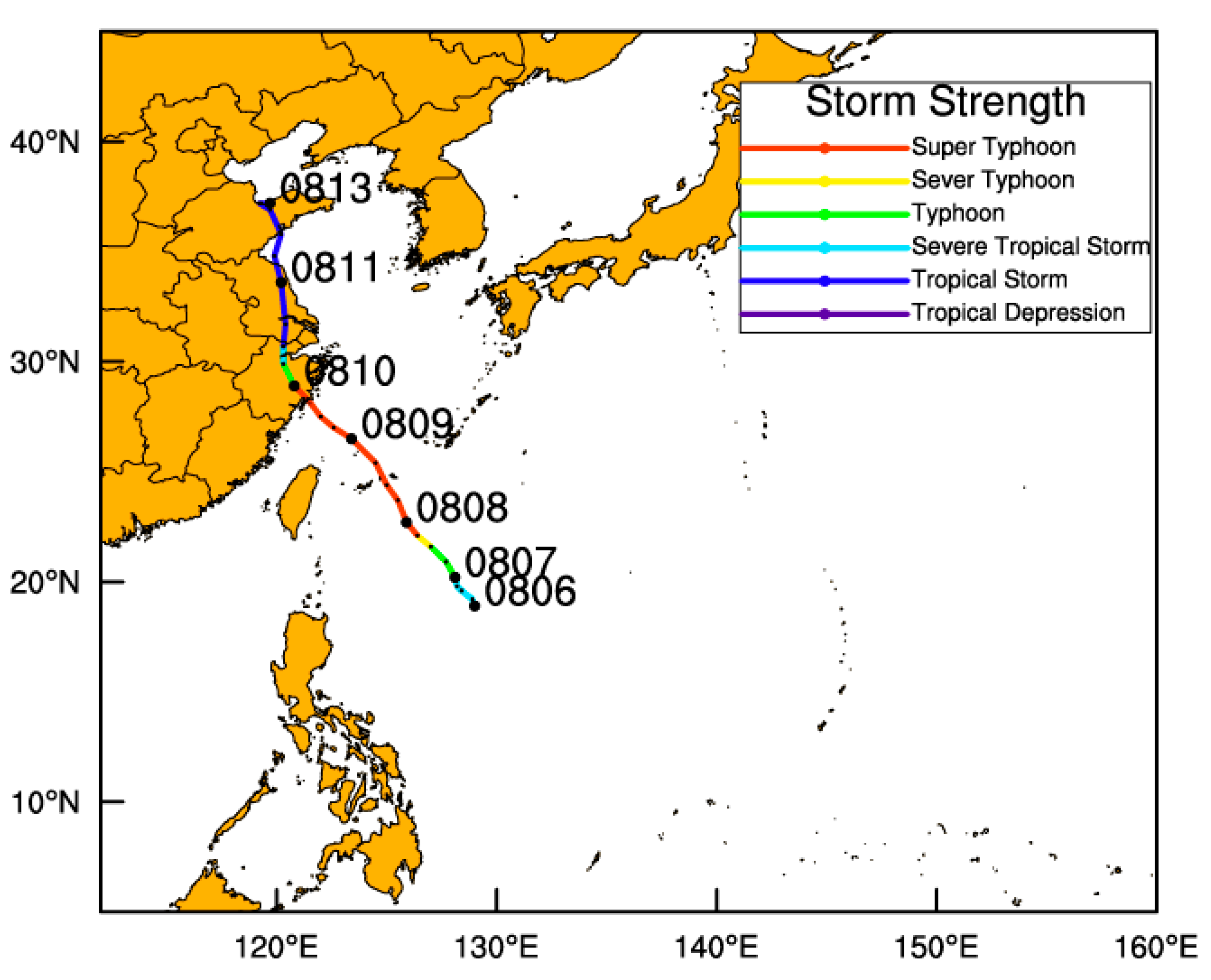
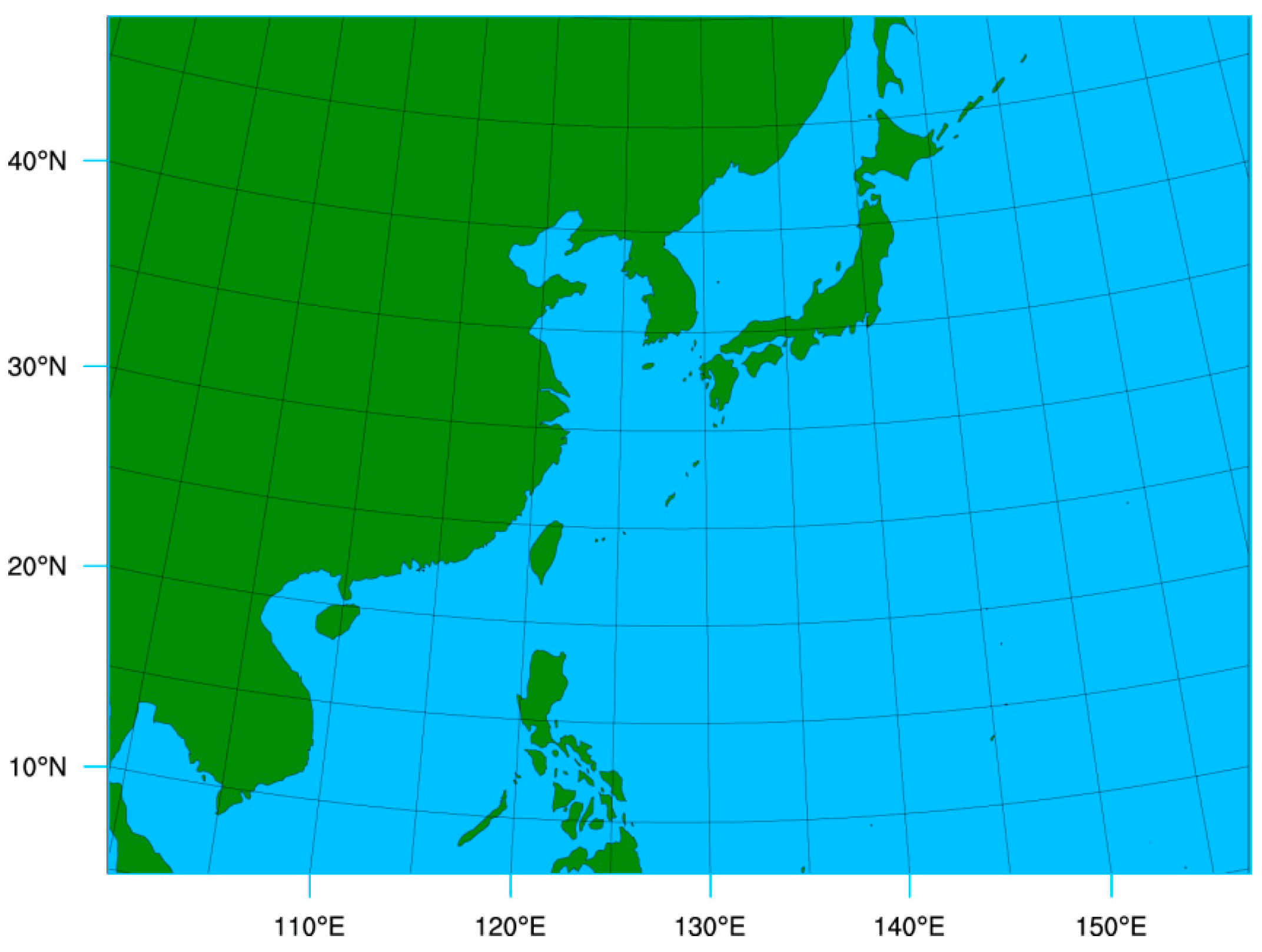
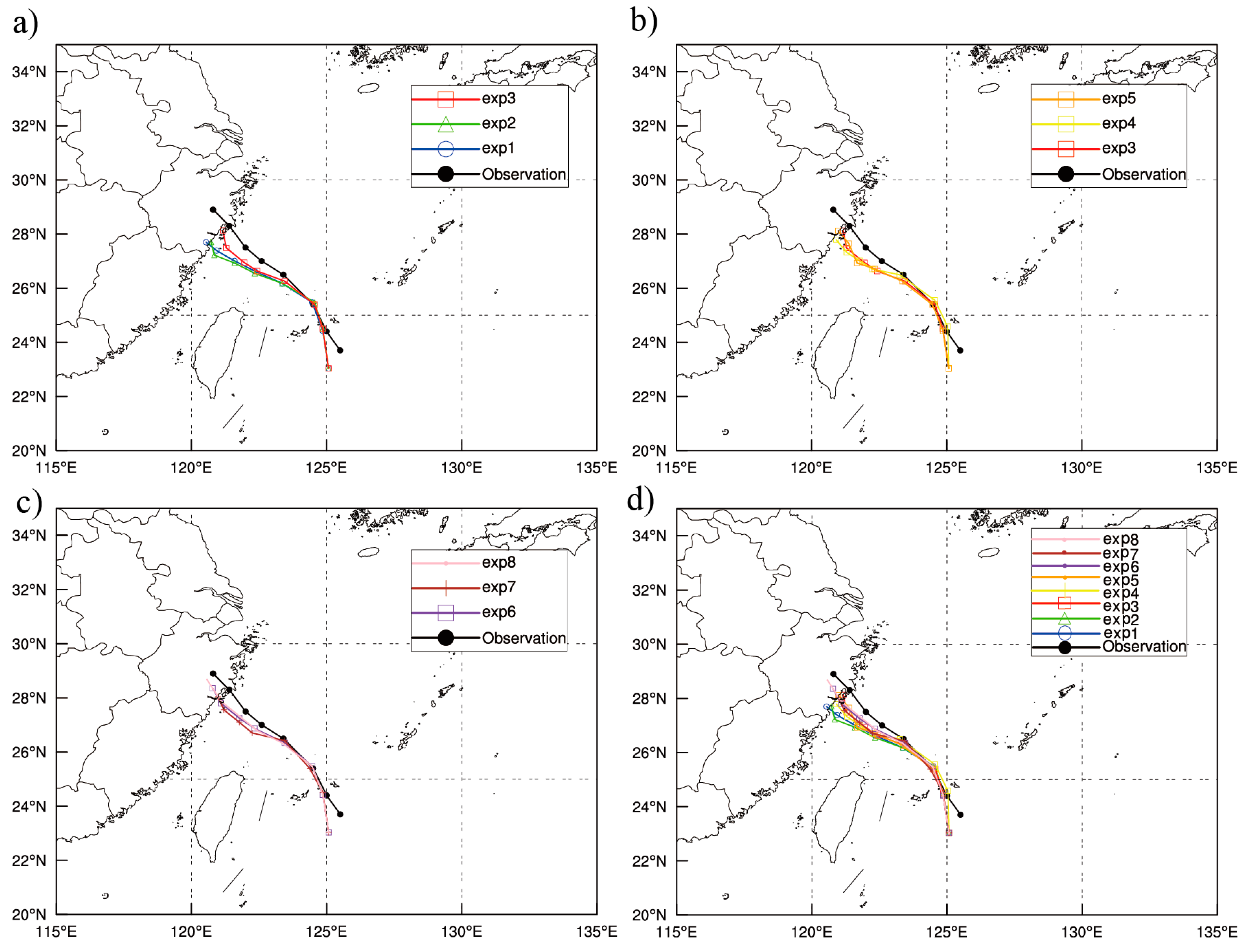
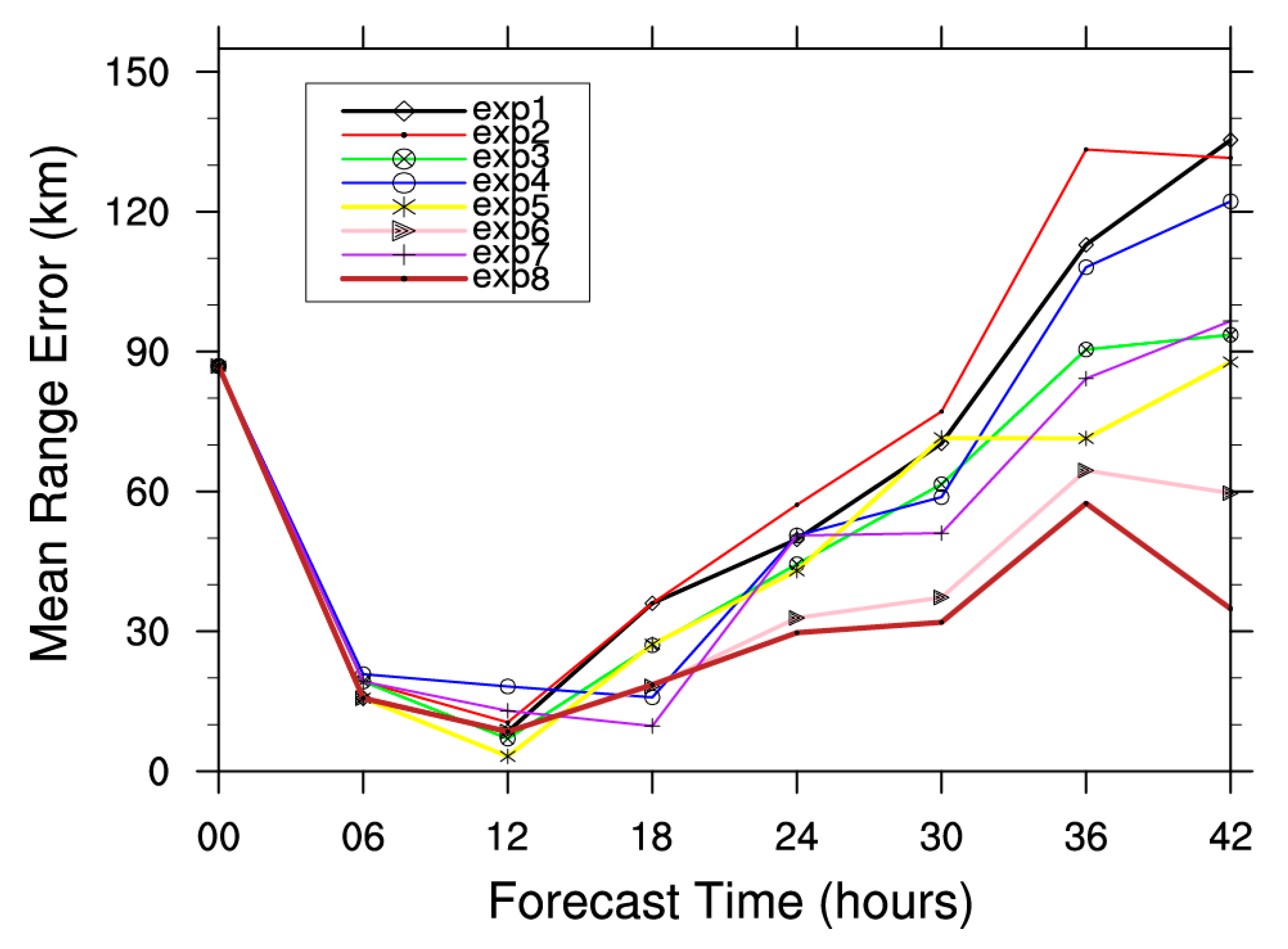
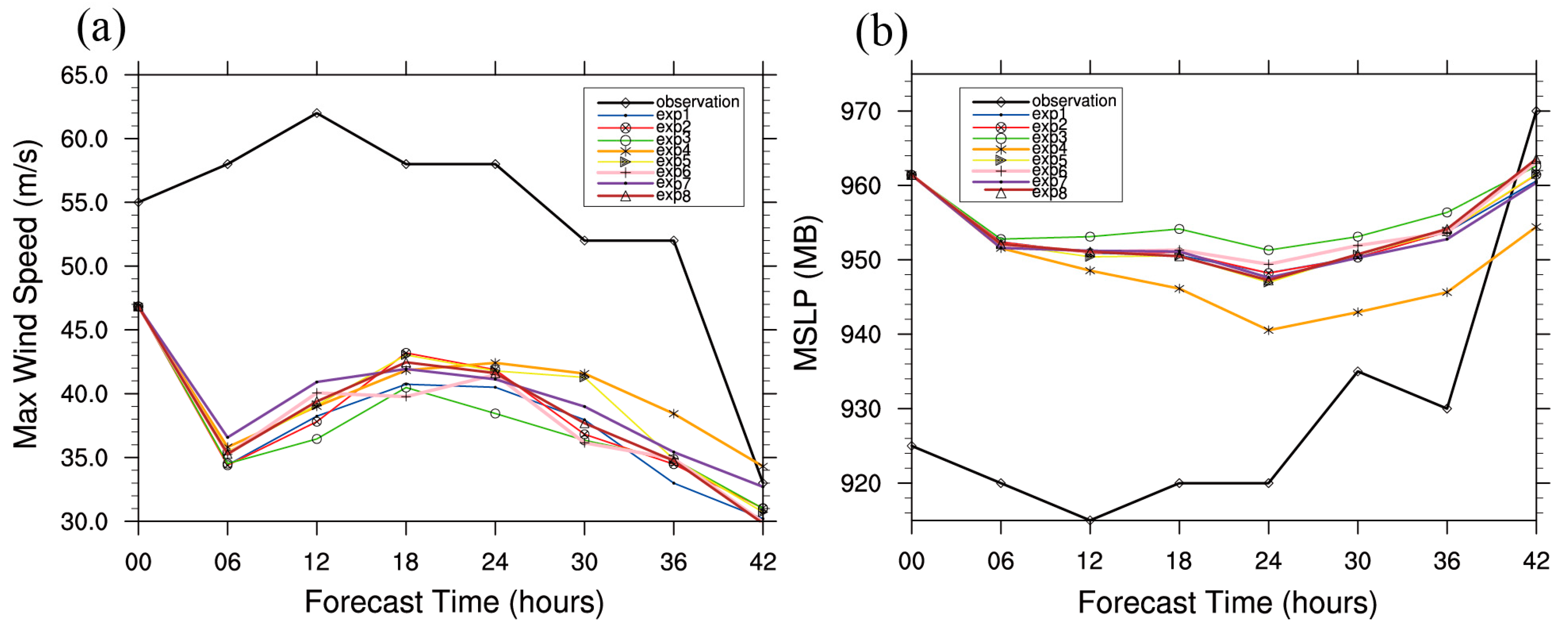
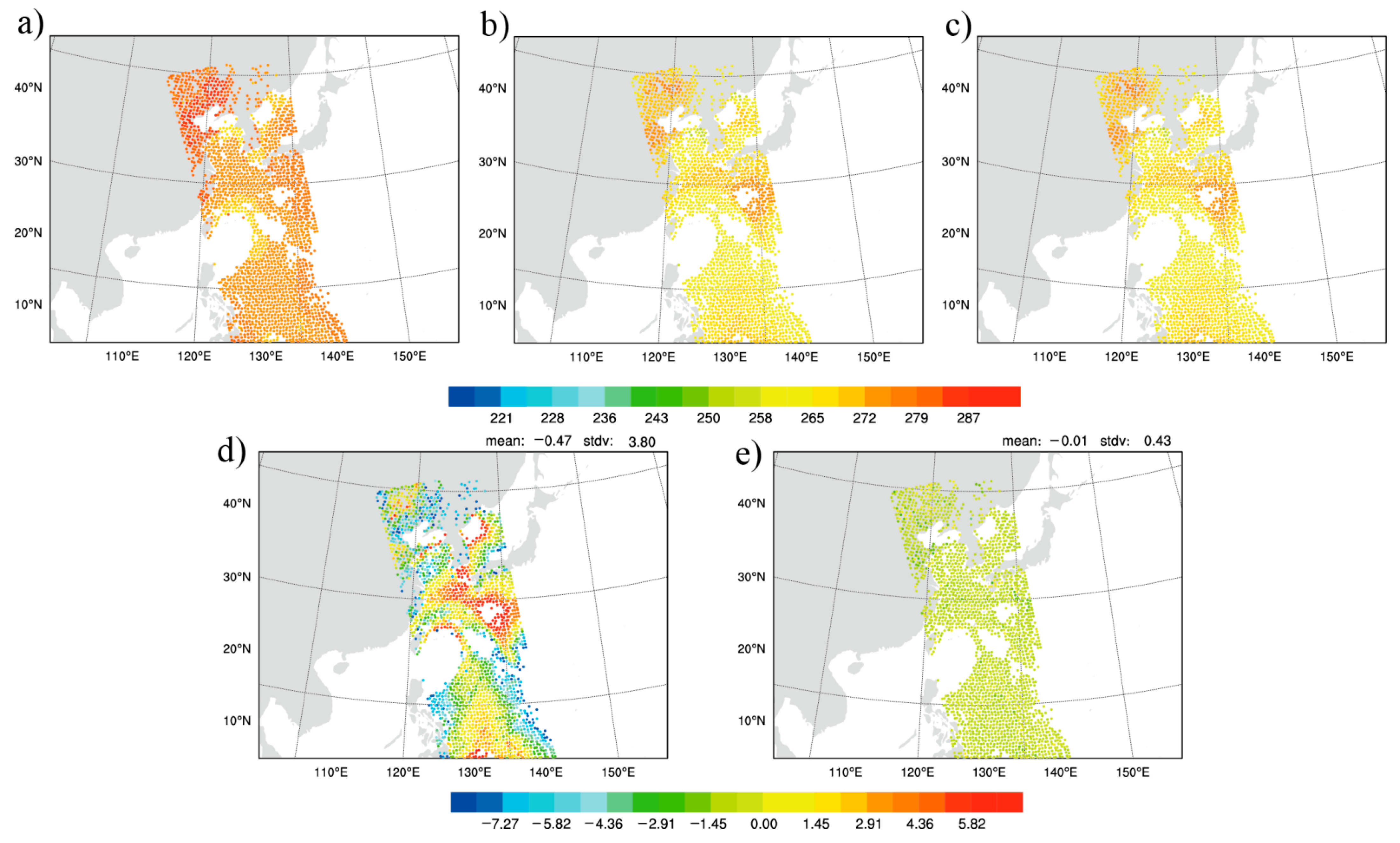
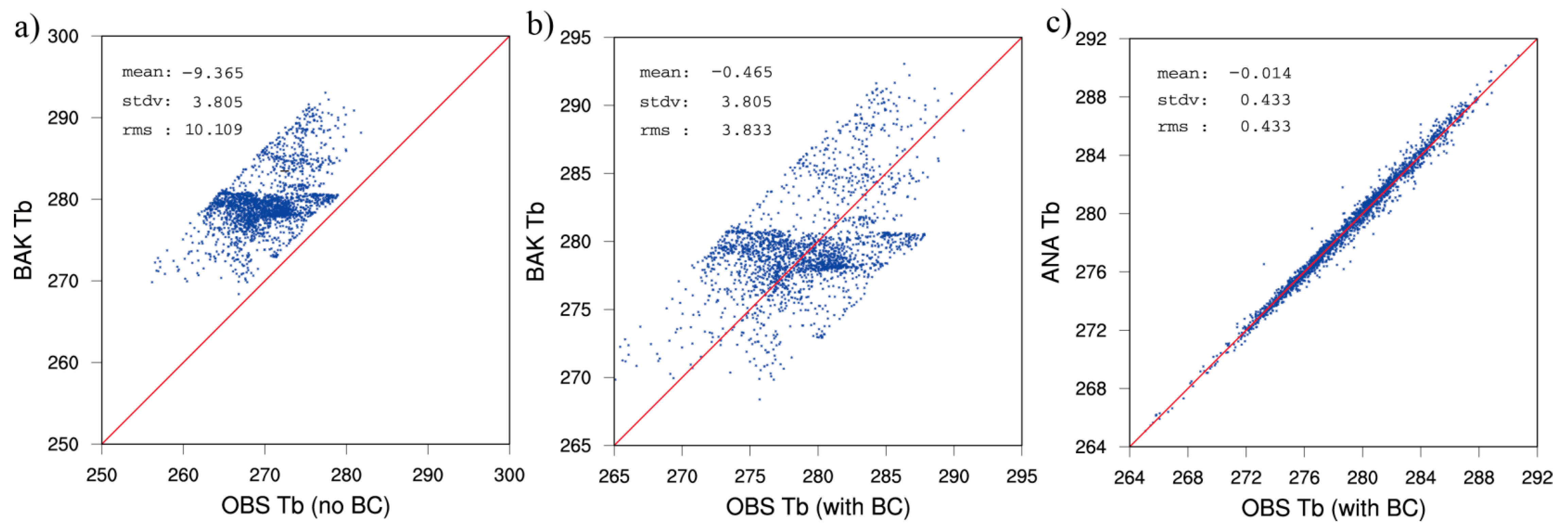
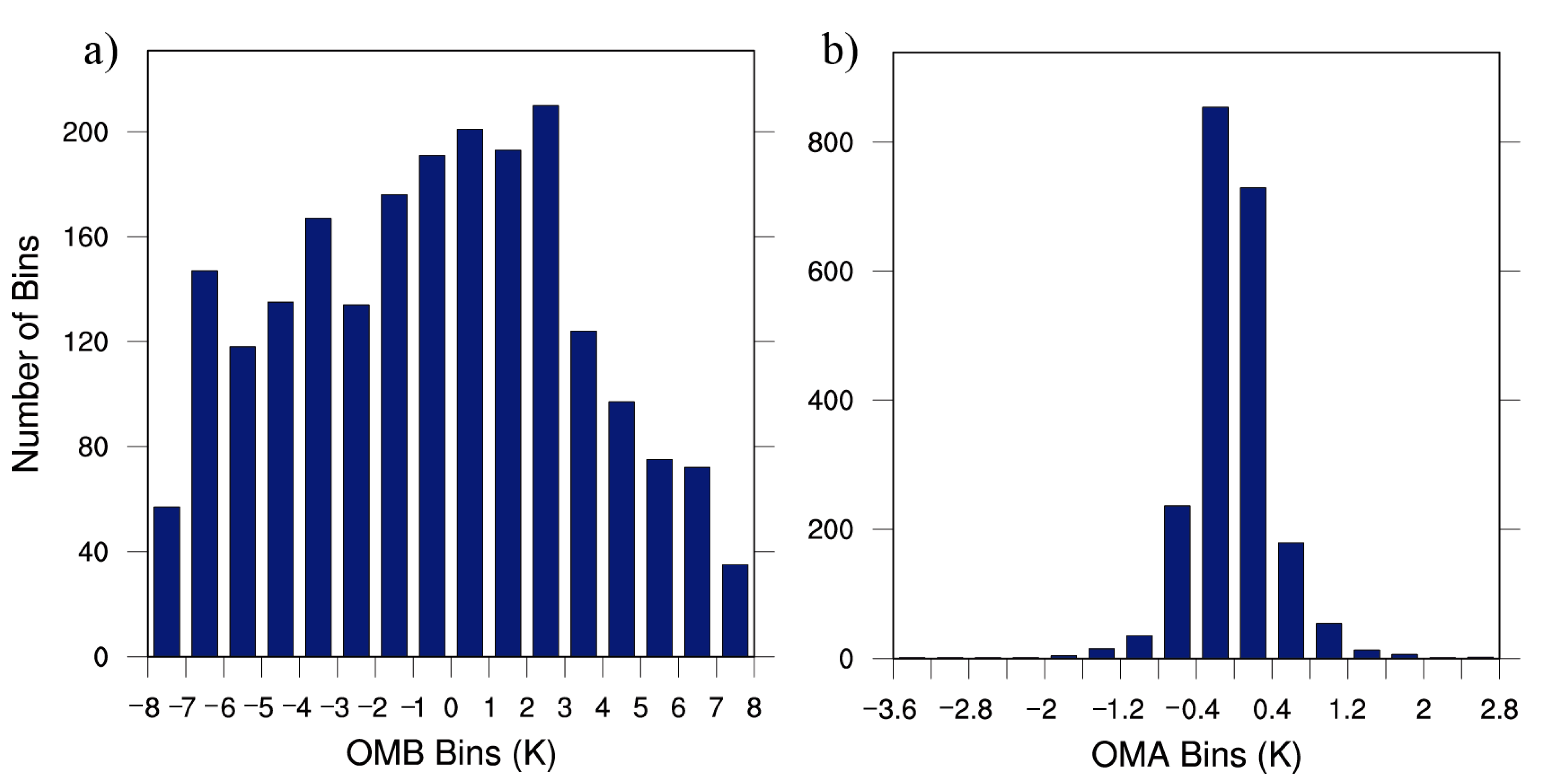
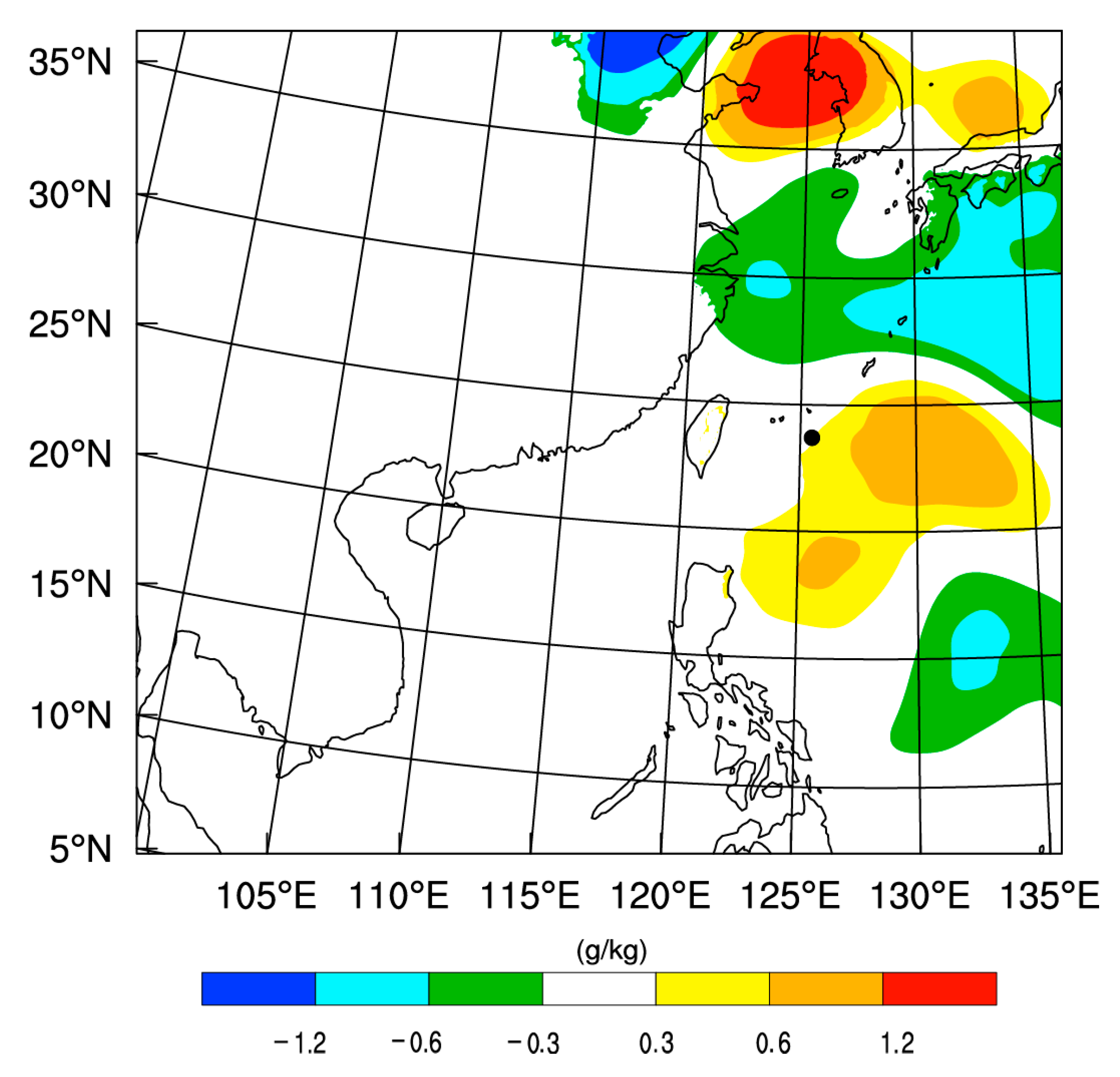
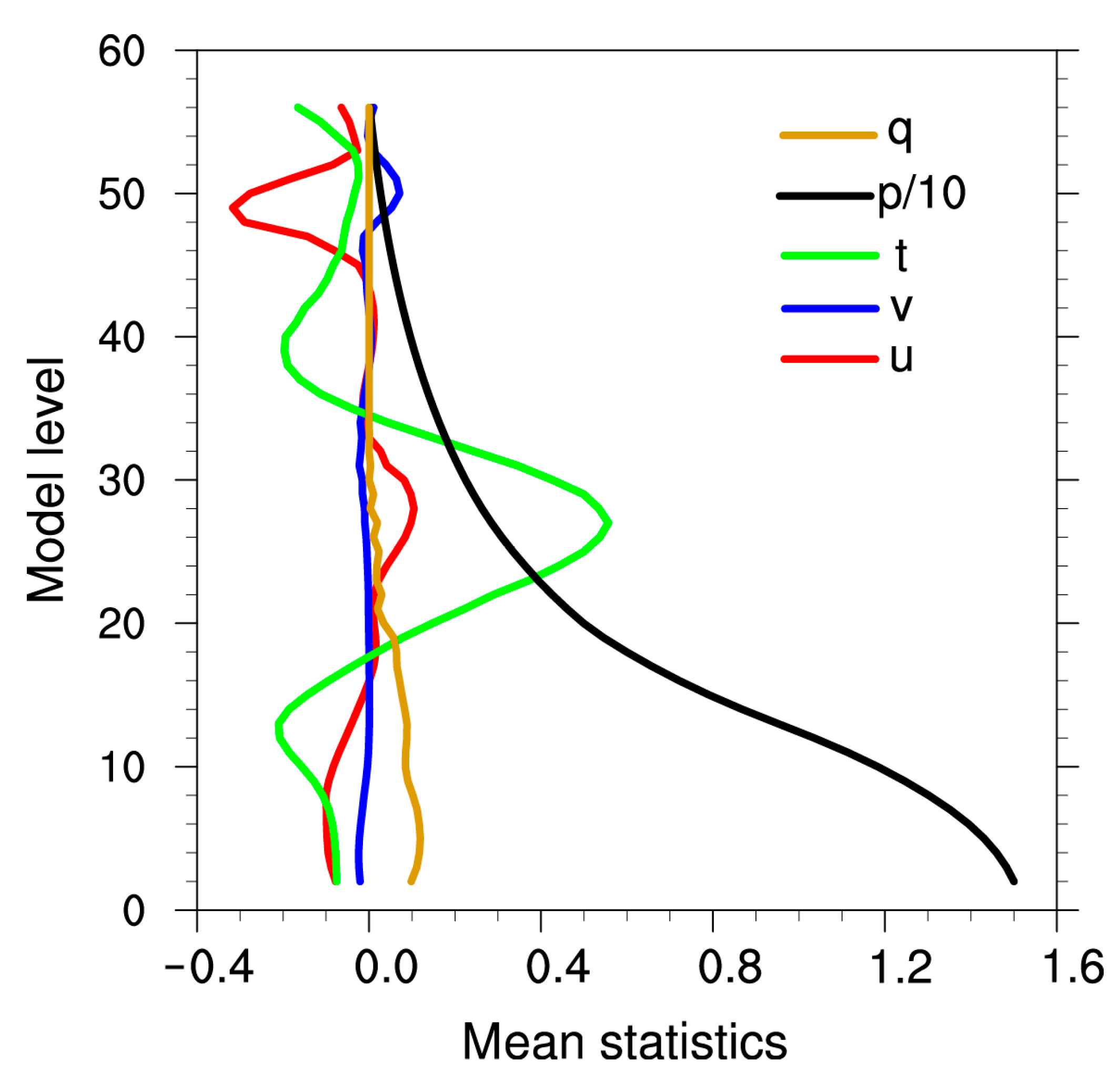
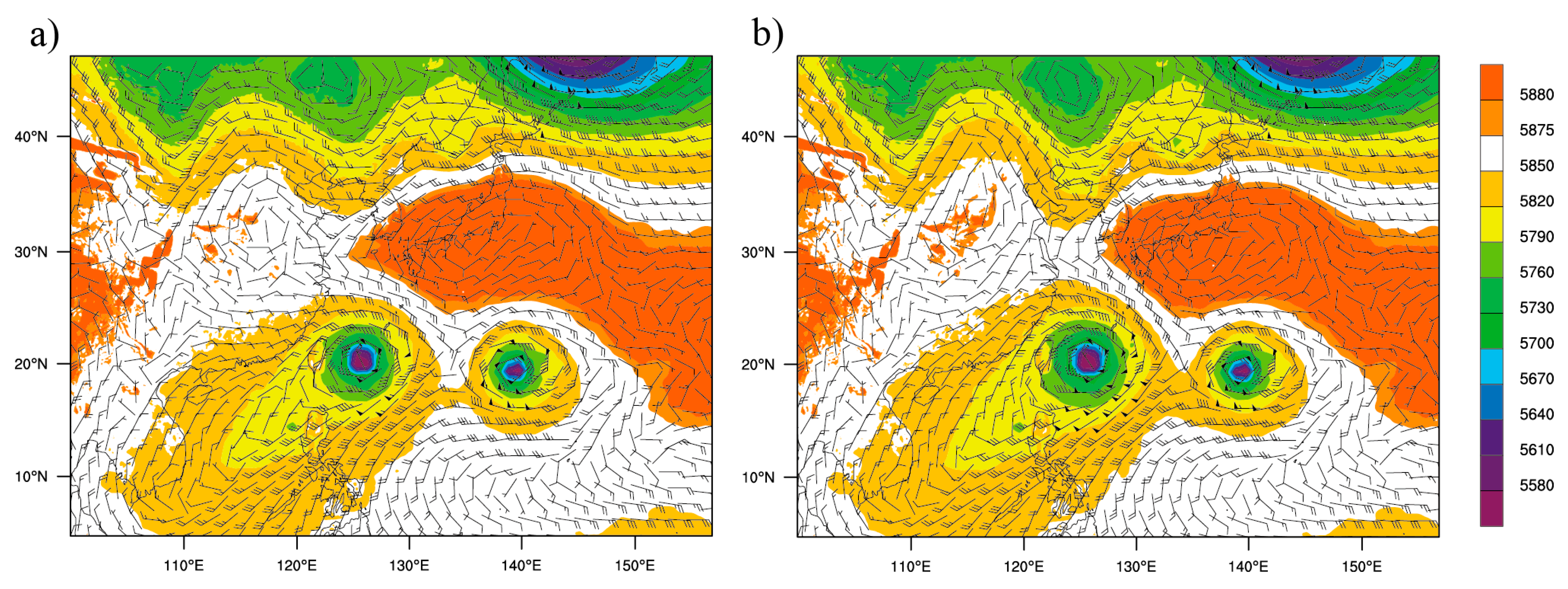
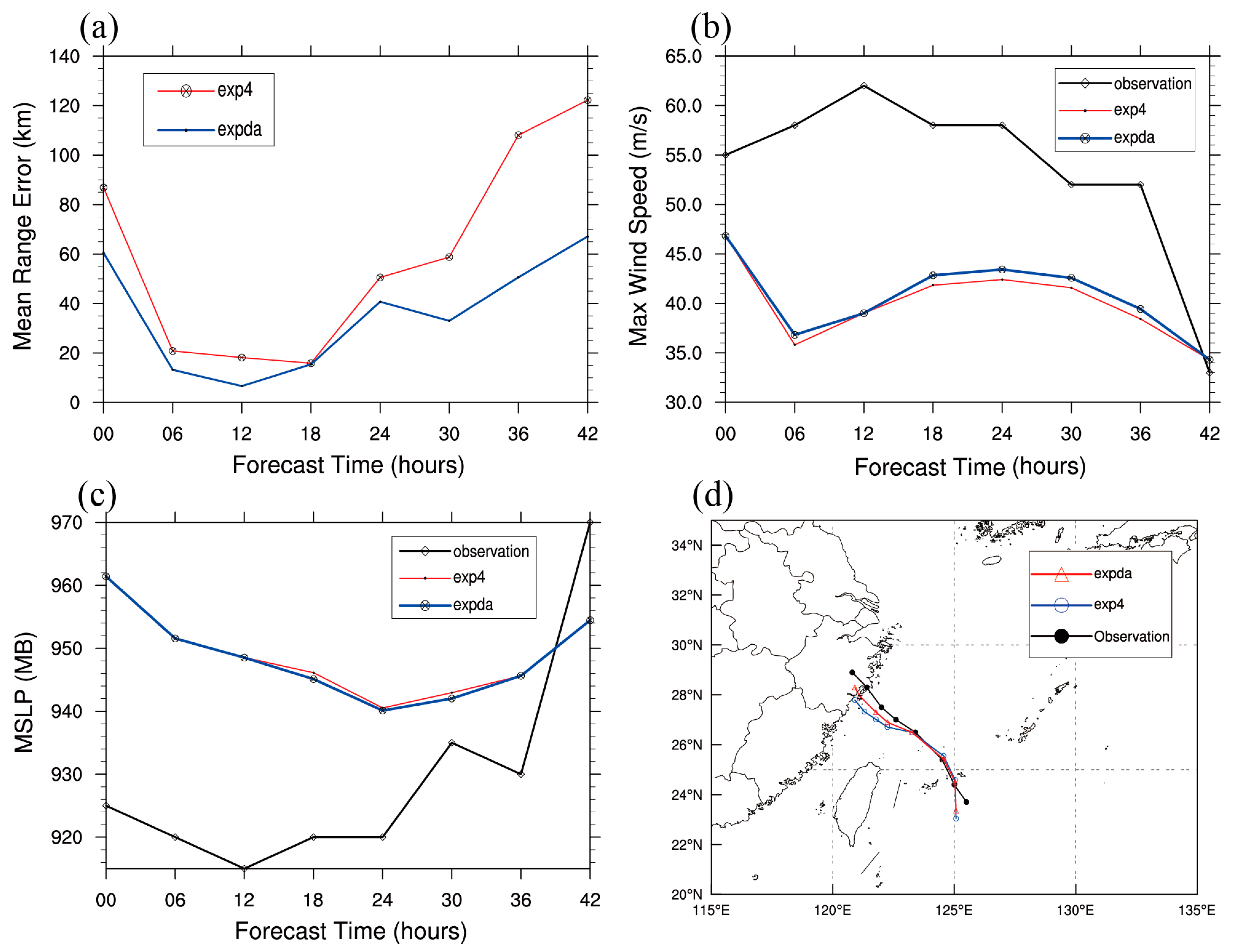
| Channel | Center Frequency (GHz) | Direction of Polarization (Vertical—V/Horizontal—H) | Bandwidth (MHz) | Calibration Accuracy (K) | Sensitivity (K) |
|---|---|---|---|---|---|
| 1 | 89 | V | 1500 | 1.3 | 1 |
| 2 | 118.75 ± 0.08 | H | 20 | 2 | 3.6 |
| 3 | 118.75 ± 0.2 | H | 100 | 2 | 2 |
| 4 | 118.75 ± 0.3 | H | 165 | 2 | 1.6 |
| 5 | 118.75 ± 0.8 | H | 200 | 2 | 1.6 |
| 6 | 118.75 ± 1.1 | H | 200 | 2 | 1.6 |
| 7 | 118.75 ± 2.5 | H | 200 | 2 | 1 |
| 8 | 118.75 ± 3.0 | H | 1000 | 2 | 1 |
| 9 | 118.75 ± 5.0 | H | 2000 | 2 | 1 |
| 10 | 150 | V | 1500 | 1.3 | 1 |
| 11 | 183.31 ± 1 | H | 500 | 1.3 | 1 |
| 12 | 183.31 ± 1.8 | H | 700 | 1.3 | 1 |
| 13 | 183.31 ± 3.0 | H | 1000 | 1.3 | 1 |
| 14 | 183.31 ± 4.5 | H | 2000 | 1.3 | 1 |
| 15 | 183.31 ± 7 | H | 2000 | 1.3 | 1 |
| Physical Process | Options | Parameterization Schemes | Short Name |
|---|---|---|---|
| mp_physics | 10 | Morrison 2-moment scheme | Morrison |
| 8 | Thompson scheme | Thompson | |
| 6 | WRF single-moment 6-class scheme | WSM6 | |
| 16 | WRF double Moment 5-class and 6-class schemes | WDM6 | |
| ra_lw_physics | 1 | RRTM longwave Scheme | RL |
| 4 | RRTMG shortwave and longwave schemes | RGSL | |
| ra_sw_physics | 1 | Dudhia Shortwave scheme | DS |
| 2 | Goddard shortwave Scheme | GS | |
| 4 | RRTMG shortwave and longwave schemes | RGSL | |
| sf_sfclay_physics | 1 | Revised MM5 scheme | RMM5 |
| 2 | Eta similarity Scheme | ES | |
| sf_surface_physics | 1 | 5–layer thermal diffusion scheme | 5-LTD |
| 2 | Unified Noah land surface model | UNLS | |
| bl_pbl_physics | 1 | Yonsei University scheme (YSU) | YSU |
| 2 | Mellor–Yamada–Janjic scheme (MYJ) | MYJ |
| UTC | Typhoon Center/(°N, °E) | MSLP/hPa | Maximum Wind Speed/(m/s) | Move Speed/(km/h) | Moving Direction | |
|---|---|---|---|---|---|---|
| August | 8th, 0600 | 23.7, 125.5 | 925 | 55 | 18 | Northwest |
| 8th, 1200 | 24.4, 125.0 | 920 | 58 | 22 | Northwest | |
| 8th, 1800 | 25.4, 124.5 | 915 | 62 | 22 | Northwest | |
| 9th, 0000 | 26.5, 123.4 | 920 | 58 | 13 | Northwest | |
| 9th, 0600 | 27.0, 122.6 | 920 | 58 | 15 | Northwest | |
| 9th, 1200 | 27.5, 122.0 | 935 | 52 | 15 | Northwest | |
| 9th, 1800 | 28.3, 121.4 | 930 | 52 | 18 | North-Northwest | |
| 10th, 0000 | 28.9, 120.8 | 970 | 33 | 15 | North-Northwest | |
| Test exps | exp1 | exp2 | exp3 | exp4 | exp5 | exp6 | exp7 | exp8 | |
|---|---|---|---|---|---|---|---|---|---|
| Physical Process | |||||||||
| mp_physics | 10-Morrison | 10-Morrison | 8-Thompson | 8-Thompson | 8-Thompson | 6-WSM6 | 16-WDM6 | 6-WSM6 | |
| ra_lw_physics | 1-RL | 4-RGSL | 4-RGSL | 1-RL | 1-RL | 1-RL | 1-RL | 4-RGSL | |
| ra_sw_physics | 1-DS | 4-RGSL | 4-RGSL | 1-DS | 2-GS | 1-DS | 1-DS | 4-RGSL | |
| sf_sfclay_physics | 2-ES | 2-ES | 2-ES | 2-ES | 1-RMM5 | 1-RMM5 | 1-RMM5 | 1-RMM5 | |
| sf_surface_physics | 2-UNLS | 2-UNLS | 2-UNLS | 1-5LTD | 1-5LTD | 2-UNLS | 2-UNLS | 2-UNLS | |
| bl_pbl_physics | 2-MYJ | 2-MYJ | 2-MYJ | 2-MYJ | 1-YSU | 1-YSU | 1-YSU | 1-YSU | |
| num_soli_layers | 4 | 4 | 4 | 5 | 5 | 4 | 4 | 4 | |
Publisher’s Note: MDPI stays neutral with regard to jurisdictional claims in published maps and institutional affiliations. |
© 2021 by the authors. Licensee MDPI, Basel, Switzerland. This article is an open access article distributed under the terms and conditions of the Creative Commons Attribution (CC BY) license (https://creativecommons.org/licenses/by/4.0/).
Share and Cite
Xu, D.; Zhang, X.; Li, H.; Wu, H.; Shen, F.; Shu, A.; Wang, Y.; Zhuang, X. Evaluation of the Simulation of Typhoon Lekima (2019) Based on Different Physical Parameterization Schemes and FY-3D Satellite’s MWHS-2 Data Assimilation. Remote Sens. 2021, 13, 4556. https://doi.org/10.3390/rs13224556
Xu D, Zhang X, Li H, Wu H, Shen F, Shu A, Wang Y, Zhuang X. Evaluation of the Simulation of Typhoon Lekima (2019) Based on Different Physical Parameterization Schemes and FY-3D Satellite’s MWHS-2 Data Assimilation. Remote Sensing. 2021; 13(22):4556. https://doi.org/10.3390/rs13224556
Chicago/Turabian StyleXu, Dongmei, Xuewei Zhang, Hong Li, Haiying Wu, Feifei Shen, Aiqing Shu, Yi Wang, and Xiaoran Zhuang. 2021. "Evaluation of the Simulation of Typhoon Lekima (2019) Based on Different Physical Parameterization Schemes and FY-3D Satellite’s MWHS-2 Data Assimilation" Remote Sensing 13, no. 22: 4556. https://doi.org/10.3390/rs13224556
APA StyleXu, D., Zhang, X., Li, H., Wu, H., Shen, F., Shu, A., Wang, Y., & Zhuang, X. (2021). Evaluation of the Simulation of Typhoon Lekima (2019) Based on Different Physical Parameterization Schemes and FY-3D Satellite’s MWHS-2 Data Assimilation. Remote Sensing, 13(22), 4556. https://doi.org/10.3390/rs13224556







